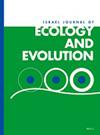两栖动物和节肢动物捕食者对粪蝇的实验性大小和性别捕食
IF 0.8
4区 环境科学与生态学
Q3 ECOLOGY
引用次数: 2
摘要
由于自然界中捕食者与猎物的相互作用是多种多样的,将现象学捕食率与潜在的行为或生态机制联系起来是一项挑战。体型和性别特异性捕食被认为是保持动物小型的主要选择性力量,指导着体型和性别体型的进化。我们通过实验评估了4种两栖动物和3种节肢动物(昆虫、苍蝇、蜘蛛)对3种粪蝇的捕食,这些粪蝇具有相似的生态,但体型、性大小二态性和颜色不同。捕食者被提供了一个猎物物种的雄性和/或雌性个体的大小范围。根据最佳觅食理论,正如预期的那样,一些无尾蟾蜍(Bufo Bufo)更喜欢体型较大的猎物,而另一些无尾蛙(Bombina variagata,Rana esculenta)则没有表现出偏好。小型幼年蛙喜欢小型猎物,所有节肢动物捕食者也是如此,这种模式可以用缺口限制或较大的猎物更好地逃脱来解释。据推测,流动性更强的雄性并没有比神秘的雌性更频繁或更快地被捕食,即使是在颜色明显的情况下。与预期相反,促进交配活动的混合群体中的苍蝇的捕食率并不高,捕食也不具有普遍的性别特异性,因此对两性异形的贡献很小。我们得出的结论是,捕食者的体型选择性,以及对其猎物的生存能力选择模式,除了任何特定的猎物防御机制外,还主要取决于两者的相对体型。因此,捕食机制的研究需要整合捕食者和猎物的视角,捕食现象学领域的研究仍然不可或缺。本文章由计算机程序翻译,如有差异,请以英文原文为准。
Experimental size- and sex-specific predation on dung flies by amphibian and arthropod predators
Because predator-prey interactions in nature are multifarious, linking phenomenological predation rates to underlying behavioral or ecological mechanisms is challenging. Size- and sex-specific predation has been implicated as a major selective force keeping animals small, directing the evolution of body size and sexual size dimorphism. We experimentally assessed predation by 4 amphibian and 3 arthropod species (bug, fly, spider) on 3 species of dung flies with similar ecology but contrasting body sizes, sexual size dimorphism, and coloration. Predators were offered a size range of male and/or female individuals of one prey species. As expected based on optimal foraging theory, some anurans (Bufo bufo) preferred larger prey individuals, others (Bombina variagata, Rana esculenta) showed no preference. Small juvenile Rana temporaria metamorphs preferred small prey, as did all arthropod predators, a pattern that may be explained by gape limitation or larger prey escaping better. Presumably more mobile males were not preyed upon more frequently or faster than cryptic females, even when conspicuously colored. Contrary to expectation, predation rates on flies in mixed groups facilitating mating activity were not higher, nor was predation generally sex-specific, hence contributing little to sexual dimorphism. We conclude that the size-selectivity of predators, and hence the viability selection pattern exerted on their prey, depends foremost on the relative body sizes of the two in a continuous fashion, in addition to any specific prey defense mechanisms. Therefore, the mechanistic study of predation requires integration of both the predator and prey perspectives, and phenomenological field studies of predation remain indispensable.
求助全文
通过发布文献求助,成功后即可免费获取论文全文。
去求助
来源期刊

Israel Journal of Ecology & Evolution
环境科学-进化生物学
CiteScore
2.10
自引率
0.00%
发文量
7
审稿时长
>36 weeks
期刊介绍:
The Israel Journal of Ecology and Evolution includes high-quality original research and review papers that advance our knowledge and understanding of the function, diversity, abundance, distribution, and evolution of organisms. We give equal consideration to all submissions regardless of geography.
 求助内容:
求助内容: 应助结果提醒方式:
应助结果提醒方式:


